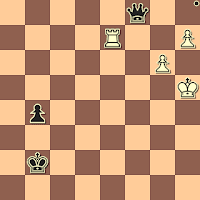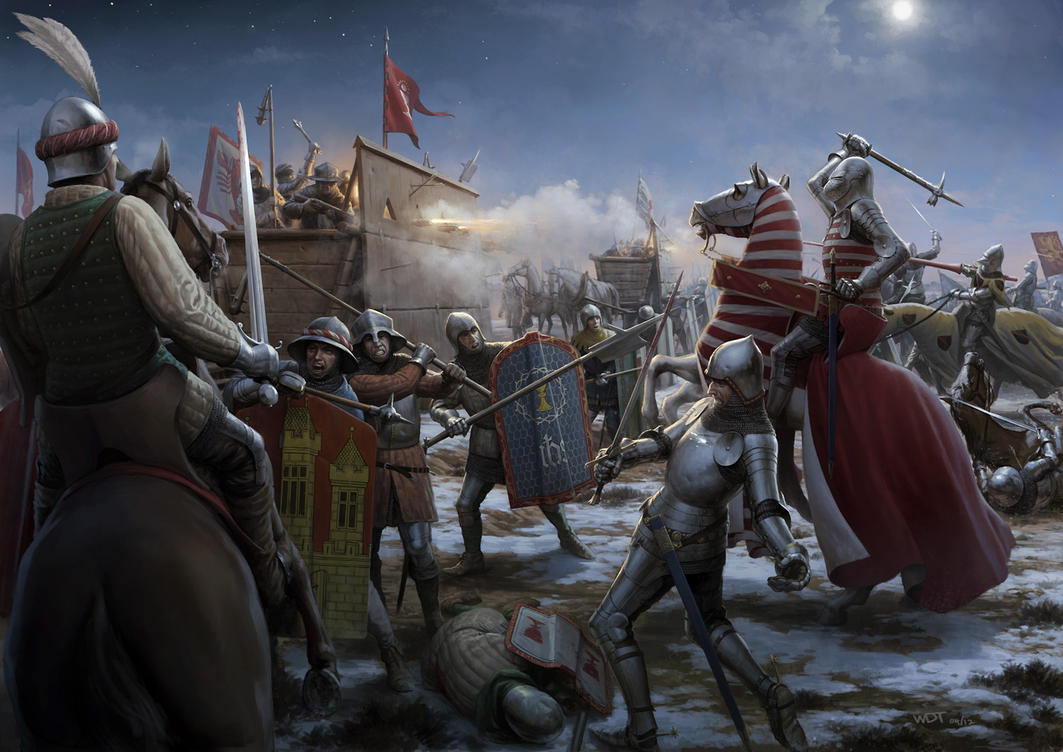Torneo tematico GaJero00-A 2009
1 2 3 4 5 6 7 8
1 Rybka 2.3.2a (2 CPU) ** 11 01 01 1½ 11 11 11 11.5/14
2 WB Nimzo 2000b 00 ** 01 11 1½ 11 ½1 11 10.0/14
3 SOS 5.1 10 10 ** 00 11 11 11 ½1 9.5/14
4 Comet B48 10 00 11 ** 10 01 11 11 9.0/14
5 Zarkov 4.70 0½ 0½ 00 01 ** 1½ 01 11 6.5/14
6 DrunkenMaster 1.2 00 00 00 10 0½ ** 10 11 4.5/14
7 La Dame Blanche 2.0c 00 ½0 00 00 10 01 ** 01 3.5/14
8 Demon 1.0 00 00 ½0 00 00 00 10 ** 1.5/14
The following game from the Jerome Gambit thematic chess tournament presented at the Scacchi64.com website provides a framework for how a number of computer chess programs address a particular opening line. (I have been guided in my own assessments by Stockfish 7.)
La Dame Blanche 2.0c - Comet B48
Torneo tematico GaJero00-A, 2009
1.e4 e5 2.Nf3 Nc6 3.Bc4 Bc5 4.Bxf7+
4...Kxf7 5.O-O Nf6 6.Nxe5+ Nxe5 7.d4 Qe7
A bit better is 7... Bxd4 8. Qxd4 d6 (8...Nc6 9. Qc4+ [9. Qa4 Qe7 10.Nc3 Qb4 11.Qxb4 Nxb4 12.e5 Nxc2 13.Rb1 Ne8 14.Bf4 c5 15.h3 b6 16.Rbc1 Nd4 17.Rcd1 Ba6 18.Rfe1 Kg6 19.Rd2 Nc7 20.Be3 Nce6 21.a3 Rhf8 22.b4 Rf5 23.bxc5 bxc5 24.f4 Nxf4 25.Bxf4 Rxf4 26.Nd5 Rff8 27.Nc7 Bb5 28.Rxd4 cxd4 29.Nxb5 Rf4 30.e6 d3 31.Rd1 dxe6 32.Rxd3 Kf6 33.Kh2 a5 34.Kg3 g5 35.Rd7 Rb8 36.Nd6 Rb3+ 37.Kh2 Kg6 38.Rc7 Rxa3 39.Nc4 Ra2 40.Ne5+ Kf5 41.Nd3 Rd4 42.Rf7+ Ke4 43.Nf2+ Kd5 44.Rd7+ Kc4 45.Rc7+ Kb5 46.Rf7 Rdd2 47.Kg1 Rxf2 48.Rxf2 Rxf2 49.Kxf2 Kc4 50.Ke1 Kc3 51.Kd1 Kb2 52.Ke2 Kc2 53.Kf3 White resigned, Demon 1.0 - Rybka 2.3.2a, Torneo tematico GaJero00-A, 2009] 9...d5 10.exd5 Qxd5 11.Qxd5+ Nxd5 12.c4 Ndb4 13.Nc3 Bf5 14.Bf4 Nd3 15.Nd5 Nxb2 16.Nxc7 Rac8 17.Nb5 Nxc4 18.Rac1 a6 19.Nc7 N6e5 20.h3 Rxc7 21.Bxe5 Rc6 22.Bf4 Re8 23.Rc3 Re4 24.Rf3 Re2 25.a3 Be4 26.Rc3 Nb2 27.Rg3 Rcc2 28.Be3 Nc4 29.Bd4 g6 30.Kh1 Rcd2 31.Ba7 b6 32.Kg1 Ra2 33.Rc1 Bd5 34.Rd1 Ke6 35.Kh1 Rxf2 36.Re1+ Kd7 37.Rg1 Kc6 38.Rg5 Ne3 39.Rc1+ Kb7 40.Bxb6 Kxb6 41.Rb1+ Kc5 White resigned, La Dame Blanche 2.0c - Rybka 2.3.2a, Torneo tematico GaJero00-A, 2009) 9.f4 Nc6 10.Qd3 Re8 11.Qc4+ (11.Nc3 Kg8 12.f5 Ne5 13.Qg3 Nf7 14.Re1 b6 15.Bd2 Bb7 16.Qf4 Re5 17.Qf3 Qe8 18.Bf4 Bxe4 19.Nxe4 Rxe4 20.Rxe4 Qxe4 21.Qxe4 Nxe4 22.Re1 Re8 23.h4 Nf6 24.Rxe8+ Nxe8 25.Kf2 Ne5 26.Bc1 Nf6 27.Ke2 Kf7 28.Bg5 Nd5 29.h5 h6 30.Bd8 c5 31.b3 Nc6 32.c4 Nxd8 33.cxd5 Kf6 34.Kd3 Kxf5 35.Kc4 Ke4 36.Kb5 Kxd5 37.g3 a6+ 38.Kxb6 c4 39.bxc4+ Kxc4 40.Kc7 d5 41.Kxd8 Kd3 42.g4 Ke3 43.a4 White resigned, La Dame Blanche 2.0c - WB Nimzo 2000b,Torneo tematico GaJero00-A, 2009) 11...Be6 12.Qa4 Kg8 13.Nc3 a6 14.f5 Bf7 15.Qa3 Nd4 16.Rb1 Qd7 17.Rf2 Nxe4 18.Nxe4 Rxe4 19.Be3 Nxf5 20.Bg5 h6 21.Bd2 Nd4 22.Qd3 Rae8 23.Rbf1 Ne2+ 24.Kh1 Rd4 25.Qf3 Bd5 26.Qe3 Rxe3 27.Bxe3 Re4 28.Rxe2 Bc4 29.Ra1 Bxe2 30.Bd2 Qf5 31.Re1 White resigned, La Dame Blanche 2.0c - Zarkov 4.70,Torneo tematico GaJero00-A, 2009.
Also a bit better than the text is 7...d5 8.dxe5 Nxe4 9.Be3 Rf8 (9...Bxe3 10.fxe3+ Kg8 11.Nc3 Nxc3 12.bxc3 Be6 13.Qd4 Rc8 14.Qxa7 Qg5 15.Qd4 c6 16.Rf3 h5 17.Rb1 b5 18.h4 Qg6 19.Rb2 Re8 20.Rf2 Ra8 21.Qb4 Rh6 22.Qf4 Qe8 23.Rd2 Rg6 24.Rd4 Qe7 25.Rd1 Rf8 26.Qb4 c5 27.Qxb5 Rxg2+ 28.Kxg2 Qxh4 29.Qe2 Bg4 30.Rh1 Qg5 31.Qf1 Be2+ 32.Kh2 White resigned, Demon 1.0 - WB Nimzo 2000b, Torneo tematico GaJero00-A, 2009) 10.Bxc5 Nxc5 11.b4 Ne6 12.Nc3 c6 13.Qc1 Kg8 14.Ne2 Qb6 15.a3 Rf5 16.Qb2 Qc7 17.f4 g5 18.g4 Rxf4 19.Nxf4 Nxf4 20.Rae1 Bxg4 21.Kh1 Re8 22.Rxf4 gxf4 23.Rg1 h5 24.h3 Qh7 25.c4 Kf7 26.hxg4 hxg4+ 27.Qh2 Qe4+ 28.Rg2 Kg7 29.c5 g3 30.b5 Rh8 31.Qxh8+ Kxh8 32.bxc6 White resigned, Demon 1.0 - Zarkov 4.70, Torneo tematico GaJero00-A, 2009
8.dxc5 Qxc5 9.Nc3
Or, 9.Be3 Qb4 10.Bd4 Nc6 11.Bxf6 gxf6 12.Qd5+ Kg7 13.Nc3 Qxb2 14.Qd3 Ne5 15.Qd2 Qb4 16.Rab1 Qc5 17.Rb5 Qc6 18.Qe3 d6 19.f4 Ng6 20.f5 Ne5 21.Rf4 b6 22.Qg3+ Kf7 23.Rd5 Bb7 24.Qe3 Rag8 25.h3 Rg7 26.Rd4 Rhg8 27.g4 h5 28.Kf1 Ba6+ 29.Kf2 hxg4 30.h4 Rh8 31.Ra4 Rxh4 32.Rxa6 g3+ 33.Kg1 Rxf4 34.Qxf4 Qc5+ 35.Kg2 Qxc3 36.Ra3 White resigned, Demon 1.0 - Comet B48,Torneo tematico GaJero00-A, 2009
9...d6
White has only a pawn for its sacrificed piece, but has some play against Black's uncastled King.
10.Bg5 Be6 11.Bxf6 gxf6 12.Qh5+ Ke7 13.Rab1
This is a mysterious Rook move, indeed. Perhaps better was 13.Kh1, preparing 14.f4.
13...Rag8 14.Rfe1 Rg4 15.Qh3 Rhg8 16.Kh1 Rxg2
Removing White's King's protection.
17.Qxg2 Rxg2 18.Kxg2 Ng4 19.Re2 Qe5 20.f4 Qxf4 21.Kg1 Kd7 22.Rd1 Bc4 23.Red2 Qg5 24.Kh1 Qc5
White has no counterplay and soon will be vanquished.
25.Na4 Qe3 26.Nc3 Bf1 27.Nd5 Qf3+ 28.Kg1 Be2 29.Nxf6+ Nxf6 30.Rd3 Bxd3 31.Rxd3 White resigned

































